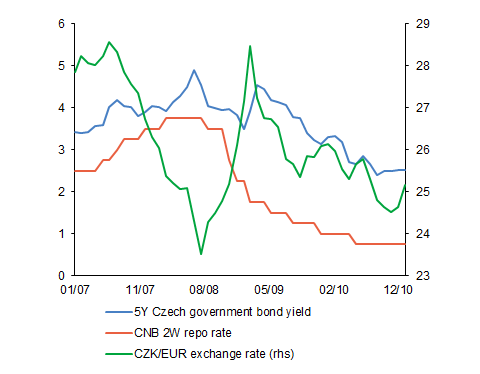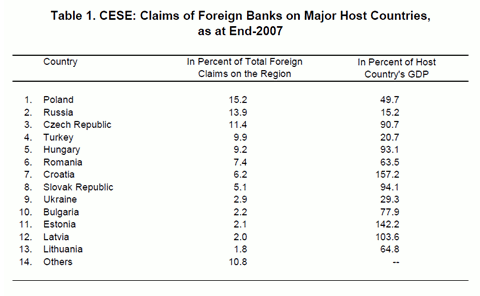Ten years since “Argentina on the Danube”
It is generally thought today that the Czech economy made it through the global financial crisis with flying colours and that the domestic banking sector also withstood the crisis with no major difficulties. In reality, however, we experienced some tough times at the CNB and we had to go to great lengths to maintain the confidence of foreign investors, multinational financial institutions and the domestic public in financial stability in the Czech Republic. The greatest pressure we were exposed to came from misleading information published by foreign media organisations and major international institutions exactly ten years ago. This information gave investors the impression that banks in the Czech Republic and other Central and Eastern European countries had – like in Hungary – borrowed large amounts of money from abroad and used it to provide risky foreign currency loans. This is where the term “Argentina on the Danube”, used in the title of this blog, comes from. In light of the current nervousness on global financial markets linked with uncertainty surrounding further developments in the world economy, it is worth reminding ourselves of how such situations arise and how challenging it can be for the central bank to deal with them.
The initial shock after the collapse of Lehman Brothers
The global financial crisis did not come out of the blue. Problems linked with risky mortgage loans had already emerged in banks in the USA and the UK in August and September 2007, but they were seen as local, isolated events having virtually no impact on the Czech economy. However, the crisis very quickly went global after US investment bank Lehman Brothers collapsed on 15 September 2008. Concerns about potential default by other financial institutions as counterparties to transactions rose dramatically on financial markets, resulting in a sharp rise in risk premia, growth in price volatility and a drop in market liquidity. This was reflected to a significant degree in the market for Czech government bonds. The CNB responded to the fall in market liquidity on 14 October 2008 by introducing two-week liquidity-supplying repo operations with government bonds as eligible collateral. On 20 November 2008, the CNB extended the range of operations to include three-month maturity ones. The measures were aimed2 at supporting the smooth functioning of the government bond market and preventing problems in foreign financial markets from spreading to the Czech financial sector. They served their purpose and the situation on this market calmed down. However, the panic on global financial markets was reflected in a slump in external demand and, in turn, in domestic economic activity. Banks started to behave more prudently. This had the negative effect of curtailing lending. However, a firm and quick response from the central bank, which cut its monetary policy rates (see the chart below), ensured that lending rates remained relatively low.
Czech government bond yields, the monetary policy rate and the exchange rate during the crisis
(left-hand scale in %; monthly averages)

Source: CNB
The Bank Board set up a crisis team made up of representatives of a whole range of units. The team met every day during the tense periods of the first phase of the crisis. Regular communication with the Ministry of Finance and the Government was a key condition for successful resolution of the crisis. In November 2008, the CNB submitted to the Government a document Current financial stability indicators and potential impacts of the global financial crisis informing it of the domestic banking sector’s high resilience and the CNB’s readiness to address the impacts of the crisis without the need to use public funds. An important element of this document was the results of stress tests of the banking sector’s ability to withstand strong shocks based on macroeconomic risk scenarios. In early February 2009, the CNB submitted a lengthy document Current forecast of macroeconomic developments and financial stability indicators to the Government. The document stated that actual macroeconomic developments were close to those in the risk scenarios presented in the November report, but still assumed that the domestic banking sector would not be a source of problems and no public funds would be needed to maintain its stability.
The second phase of the crisis in 2009
Maintaining the confidence of foreign entities turned out to be a tougher task. The global financial crisis cast doubt on the stability of emerging economies. Their currencies started to weaken and the yields required on their government bonds rose 3 . The domestic economy was no exception in this regard (see the chart above). The problems started to escalate in February 2009 when major foreign periodicals published misleading information about the financial vulnerability of the domestic economy. On 19 February 2009, the Financial Times incorrectly reported that foreign banks had lent a total of USD 192 billion (around CZK 4 trillion) to the Czech Republic as of 30 September 2008. On 21 February 2009, in an article headlined Argentina on the Danube?, the Economist wrongly stated that the Czech Republic was one of the countries where a falling currency was causing agony to households who had loans denominated in Swiss francs and euros. On 23 February 2009, the Financial Times published a commentary Eastern crisis that could wreck the eurozone warning against the situation in the banking sectors of Central and Eastern European countries. The CNB reacted robustly to this “information” by issuing statements4 . It explained that the media had misinterpreted Bank for International Settlements (BIS) source statistics consolidating the balance sheets of international banking groups. Consolidated groups include the balance sheets of local banks owned by the groups in each country. The USD 192 billion in question thus represented the sum of the balance sheets of domestic Czech banks – consisting mainly of deposits of and loans to domestic households and firms – owned by foreign banks as of a given date.
Initially, the CNB’s explanations did not entirely do the trick. However, its communication with the financial markets led the koruna to stabilise quite quickly (see the chart above). It took months, though, to convince foreign entities that the domestic financial sector was stable. This was partly because multinational institutions reproduced the data misinterpretation. Coincidentally, an IMF delegation was visiting the Czech Republic on a regular mission in late 2008 and early 2009. On 9 January 2009, it presented CNB representatives with a report informing them that it had found two sources of potentially large problems in the domestic banking sector. The first was the aforementioned – but actually non-existent – liabilities to foreign owners. A model illustration of the unfortunate interpretation of the BIS data is the IMF’s oddly titled March 2009 working paper Foreign Banks in the CESE Countries: In for a Penny, in for a Pound?“11 , which contained, for example, the table presented below.

Source: IMF Working Paper WP/09/54, p. 12.
The second “problem” noted by the IMF delegation was the alleged excessive off-balance-sheet items of domestic banks. Here, the CNB paradoxically paid a price for its high openness, as it was virtually the only central bank publishing statistics for these items. Viewed from the current perspective, it is obvious that the size of these items in Czech banks was not high by international comparison. Moreover, their material content had nothing to do with risky derivatives or other such transactions. At the time, however, the CNB did not have access to data on the situation in other countries. It is quite likely that the members of the IMF delegation did not either.
The CNB therefore expressed strong disagreement with some passages of the report. The IMF delegation was unwilling to revise the text fully, so the CNB exercised the option of delaying its publication. CNB representatives used the time gained to communicate with foreign investors, rating agencies and the wider economic community and inform them about the true state of the domestic banking sector and the inaccuracy of the conclusions drawn from the misinterpreted BIS statistics. When the IMF report was published on 14 April 20096 (it should be noted that its risk warnings had been toned down by then), its impact was almost negligible.
Could there be a repeat of the 2009 situation?
Probably all major analysts at financial and multinational institutions already knew in 2010 that the banking sector in the Czech Republic was financing its lending activity in the domestic currency using domestic funds and that households were saving and borrowing almost exclusively in koruna. Given the natural generational turnover, there is no guarantee that all today’s analysts have this knowledge. If a new global financial shock were to occur, incorrect information could easily reappear and erode confidence in the stability of the domestic financial sector. The CNB is prepared for such a situation and knows that it must respond decisively and communicate actively in such cases. It also does so preventively via the information and analyses published in its Financial Stability Reports.
Moreover, the Czech Republic has one undeniable advantage over some other countries. Thanks to the integration of supervision of all the sectors of the financial market and all the functions needed to pursue financial stability, the CNB has instant and complete access to information about the real economy and the financial sector as a whole. It knows that it must act on its own and that it cannot rely on being able to blame any problems on other institutions. The same certainly cannot be said for all European countries.
1 The author would like to thank Libor Holub and Simona Malovaná from the CNB’s Financial Stability Department for valuable comments.
2 http://www.cnb.cz/en/financial_markets/money_market/repo_param_2008.html.
3 The yields required on five-year government bonds during the crisis never exceeded the 5% level recorded in June 2008. This level, however, had nothing to do with the situation in the financial sector, but was linked with expectations of monetary policy tightening in an environment of increased inflation pressures.
4 https://www.cnb.cz/en/public/media_service/press_releases_cnb/2009/090224_statement_FT.html.
5 https://www.imf.org/en/Publications/WP/Issues/2016/12/31/Foreign-Banks-in-the-CESE-Countries-In-for-a-Penny-in-for-a-Pound-22781. The original version of the paper, to which the CNB responded with fundamental comments in January 2009, had an even more problematic title: Foreign Banks in the CESE Countries: In for a Penny, in for a Pound…or Penny-Wise, Pound-Foolish? and contained even more strongly worded conclusions.
6 https://www.imf.org/external/pubs/ft/scr/2009/cr09122.pdf. See point 13 on p. 8 and point 20 on pp. 13–14.